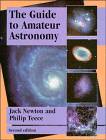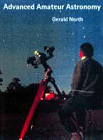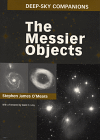|
There are a large number of books available to help the amateur astronomer. This
section lists the books that I have used, what they have taught me and what I think of
them.
Introduction to amateur astronomy
      The Guide to Amateur Astronomy (Jack Newton and
Philip Teece). This was one of the first astronomical books that I
purchased and it is a useful book for those new to amateur astronomy. It describes
the basics of how to choose a telescope, find objects and observe them. As
well as sections on how to observe the planets, sun and moon, it also describes the
various other types of astronomical objects that can be seen and tells you which are
visible during the various seasons. There are also sections that show the beginner how to
photograph objects as well as take CCD images. For the adventurous there is also a
section on how to make your own telescope. Order
a copy today! The Guide to Amateur Astronomy (Jack Newton and
Philip Teece). This was one of the first astronomical books that I
purchased and it is a useful book for those new to amateur astronomy. It describes
the basics of how to choose a telescope, find objects and observe them. As
well as sections on how to observe the planets, sun and moon, it also describes the
various other types of astronomical objects that can be seen and tells you which are
visible during the various seasons. There are also sections that show the beginner how to
photograph objects as well as take CCD images. For the adventurous there is also a
section on how to make your own telescope. Order
a copy today!
Advanced amateur astronomy techniques and theory
      Advanced Amateur Astronomy (Gerald North).
Once I had mastered the basics I found that I wanted more detailed information on
telescope optics and photographic techniques. This book proved ideal for this
purpose and I still refer to it to this day. It has a good introductory section on
telescope optics that will soon allow you to understand and calculate f-ratios, image
scales and magnification factors. The reader is told how to recognise the various
types of optical problems and what to do about them. Later, there are sections on
the techniques required for astrophotography and CCD imaging followed by detailed
descriptions of how to observe, photograph and image the Sun, Moon, Planets, galaxies,
nebulae, star clusters, double stars, supernovae, comets, meteors, auroras and variable
stars. There is also a section on how to do photometry, spectroscopy and radio
astronomy. Order
a copy today! Advanced Amateur Astronomy (Gerald North).
Once I had mastered the basics I found that I wanted more detailed information on
telescope optics and photographic techniques. This book proved ideal for this
purpose and I still refer to it to this day. It has a good introductory section on
telescope optics that will soon allow you to understand and calculate f-ratios, image
scales and magnification factors. The reader is told how to recognise the various
types of optical problems and what to do about them. Later, there are sections on
the techniques required for astrophotography and CCD imaging followed by detailed
descriptions of how to observe, photograph and image the Sun, Moon, Planets, galaxies,
nebulae, star clusters, double stars, supernovae, comets, meteors, auroras and variable
stars. There is also a section on how to do photometry, spectroscopy and radio
astronomy. Order
a copy today!
      Observing Comets, Asteroids, Meteors and the
Zodiacal Light (Stephen J. Edberg and David H. Levy). As well as describing
the techniques required to search for comets and asteroids this book also shows ways to
study them that will provide useful scientific data. Visual and photographic
observational techniques are described as well as advanced methods on making
astrometric,
spectroscopic and other electronic observations. Order
a copy today! Observing Comets, Asteroids, Meteors and the
Zodiacal Light (Stephen J. Edberg and David H. Levy). As well as describing
the techniques required to search for comets and asteroids this book also shows ways to
study them that will provide useful scientific data. Visual and photographic
observational techniques are described as well as advanced methods on making
astrometric,
spectroscopic and other electronic observations. Order
a copy today!
     Galaxy Morphology and Classification (Sidney
van den Bergh). A guide to the latest shape and classification schemes used
for galaxies along with discussion on how galaxies may transmute from one type to another
over time. Order a copy today! Galaxy Morphology and Classification (Sidney
van den Bergh). A guide to the latest shape and classification schemes used
for galaxies along with discussion on how galaxies may transmute from one type to another
over time. Order a copy today!
     The Art and Science of CCD Astronomy (ed. by David
Ratledge). This is a collection of contributions from 12 leading amateurs in the
CCD field. They describe their techniques and solutions and offer advice on choosing
and using a CCD camera. Order
a copy today!
The Art and Science of CCD Astronomy (ed. by David
Ratledge). This is a collection of contributions from 12 leading amateurs in the
CCD field. They describe their techniques and solutions and offer advice on choosing
and using a CCD camera. Order
a copy today!
      A Practical Guide to CCD Astronomy (Patrick
Martinez and Alain Klotz). This book helps you understand how a CCD works and
hence some of the key criteria on which you need to base your buying decision. It
also describes the various image processing techniques you will need to use to make the
best of your images. Order
a copy today! A Practical Guide to CCD Astronomy (Patrick
Martinez and Alain Klotz). This book helps you understand how a CCD works and
hence some of the key criteria on which you need to base your buying decision. It
also describes the various image processing techniques you will need to use to make the
best of your images. Order
a copy today!
     The Handbook of
Astronomical Image Processing (Berry and Burnell). This is a
comprehensive guide to the theory behind the processing of astronomical
images. It comes complete with a comprehensive image processing
software package AIP4WIN. The book takes you through the features of
AIP4WIN and shows you how to apply these to your images to get the best
results. Order
a copy today!
The Handbook of
Astronomical Image Processing (Berry and Burnell). This is a
comprehensive guide to the theory behind the processing of astronomical
images. It comes complete with a comprehensive image processing
software package AIP4WIN. The book takes you through the features of
AIP4WIN and shows you how to apply these to your images to get the best
results. Order
a copy today!
Observation Handbooks
      The Messier Objects (Stephen James O'Meara).
This excellent book reviews each Messier object in numerical order. As well
as giving you the background to each object there are maps and instructions on how to find
it along with drawings and descriptions of what you can expect to see through the
eyepiece. There is also a monochrome CCD image of each object taken by the author.
This book is a must for anyone interested in building up their own catalogue of
Messier object observations. Order
a copy today! The Messier Objects (Stephen James O'Meara).
This excellent book reviews each Messier object in numerical order. As well
as giving you the background to each object there are maps and instructions on how to find
it along with drawings and descriptions of what you can expect to see through the
eyepiece. There is also a monochrome CCD image of each object taken by the author.
This book is a must for anyone interested in building up their own catalogue of
Messier object observations. Order
a copy today!
     Observing Handbook and Catalogue of Deep-Sky
Objects (Christian B. Luginbuhl, Brian A. Skiff). Taking each constellation
in turn this book lists over 2000 galaxies, nebulae and star clusters. Objects range
from those visible in binoculars to faint objects requiring apertures of 30cm.
Charts to help locate the objects are provided for each constellation. The
description of each object includes its dimensions, its brightness and what you should
look out for when observing it. This is an excellent book for planning your
deep-sky observation session. Order
a copy today! Observing Handbook and Catalogue of Deep-Sky
Objects (Christian B. Luginbuhl, Brian A. Skiff). Taking each constellation
in turn this book lists over 2000 galaxies, nebulae and star clusters. Objects range
from those visible in binoculars to faint objects requiring apertures of 30cm.
Charts to help locate the objects are provided for each constellation. The
description of each object includes its dimensions, its brightness and what you should
look out for when observing it. This is an excellent book for planning your
deep-sky observation session. Order
a copy today!
     Stars and Planets (Ian Ridpath and Wil Tirion).
An indispensable pocket guide for field trips. This book contains maps of the whole
sky for each month of the year for both the Northern and Southern hemispheres. For
each constellation there is then a detailed map and a description of the most interesting
astronomical objects to observe. Maps of the moon are included as well as sections
on each of the planets, the Sun and background to the major types of astronomical objects
(e.g. variable stars, double stars, galaxies etc..) Order
a copy today! Stars and Planets (Ian Ridpath and Wil Tirion).
An indispensable pocket guide for field trips. This book contains maps of the whole
sky for each month of the year for both the Northern and Southern hemispheres. For
each constellation there is then a detailed map and a description of the most interesting
astronomical objects to observe. Maps of the moon are included as well as sections
on each of the planets, the Sun and background to the major types of astronomical objects
(e.g. variable stars, double stars, galaxies etc..) Order
a copy today!
Encyclopaedias of the Universe
      Atlas of the Universe (Patrick Moore).
An excellent 'Encyclopaedia of the Universe' for the beginner. Starting with
a history of astronomy through the ages, this book takes you on a tour of our solar system
and then out into the Universe. There is information, pictures and maps on all the
planets and their satellites. There is a section on the Sun followed by a
description of the life and death of a star. The major structural objects of the
Universe are explained along with detailed maps of the constellations and descriptions of
the most interesting objects to observe in them. Order
a copy today! Atlas of the Universe (Patrick Moore).
An excellent 'Encyclopaedia of the Universe' for the beginner. Starting with
a history of astronomy through the ages, this book takes you on a tour of our solar system
and then out into the Universe. There is information, pictures and maps on all the
planets and their satellites. There is a section on the Sun followed by a
description of the life and death of a star. The major structural objects of the
Universe are explained along with detailed maps of the constellations and descriptions of
the most interesting objects to observe in them. Order
a copy today!
     Skywatching (David Levy).
This book contains much of the same information as the Atlas of the Universe.
However it also has a section on observing techniques, choosing a telescope and
basic astrophotography. All this is contained in a book which is a handy size for
taking with you on field trips. Order
a copy today! Skywatching (David Levy).
This book contains much of the same information as the Atlas of the Universe.
However it also has a section on observing techniques, choosing a telescope and
basic astrophotography. All this is contained in a book which is a handy size for
taking with you on field trips. Order
a copy today!

|

